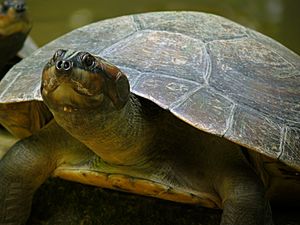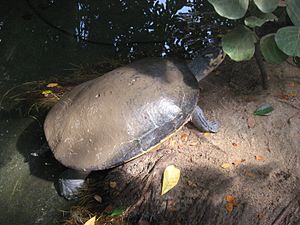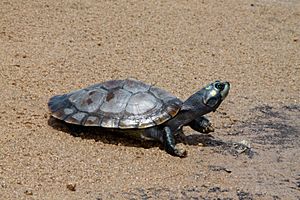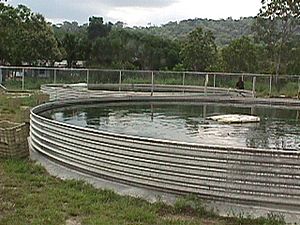Arrau turtle facts for kids
Quick facts for kids Arrau turtle |
|
|---|---|
 |
|
 |
|
| Conservation status | |
| Scientific classification | |
| Genus: |
Podocnemis
|
| Species: |
expansa
|
 |
|
| Synonyms | |
|
|
The Arrau turtle (Podocnemis expansa) is also known as the South American river turtle. It is the biggest side-neck turtle and the largest freshwater turtle in Latin America. These turtles mainly eat plants. They usually lay their eggs together in large groups on sandy beaches.
Sadly, Arrau turtles are in danger. People hunt them and collect their eggs. Pollution, losing their homes, and dams also threaten them.
Contents
Where Arrau Turtles Live
Arrau turtles live in the big river systems of South America. You can find them in the Amazon, Orinoco, and Essequibo rivers. These rivers flow through countries like Brazil, Bolivia, Peru, Ecuador, Colombia, Venezuela, and Guyana. Sometimes, after big floods, they might even show up in Trinidad.
They like deep rivers, ponds, and freshwater lagoons. They also live in flooded forests. You can find them in different types of water: white-water, black-water, and clear-water rivers.
What Arrau Turtles Look Like
Arrau turtles can grow very large! Some can weigh up to 90 kg (200 lb). Their top shell, called a carapace, can be as long as 1.07 m (3.5 ft).
Most Arrau turtles are a bit smaller. Adult females usually have a shell length of 64–71 cm (2.1–2.3 ft). Males are smaller, with shells about 40–50 cm (1.3–1.6 ft) long. Males also have longer tails and flatter shells than females.
These turtles can be brown, gray, or olive-green. Their exact color can change. This depends on the algae that grows on their shells.
Arrau Turtle Behavior
What They Eat
Adult Arrau turtles mostly eat plants. Their diet includes fruits, seeds, leaves, and algae. They might also eat freshwater sponges or dead animals like fish. Turtles kept in zoos have even eaten meat. Young Arrau turtles eat both fish and plants. These turtles are most active during the day.
Breeding and Life Cycle
When it's time to lay eggs, Arrau turtles travel to special nesting spots. They often lay their eggs in huge groups on beaches. This helps protect their eggs from animals that might try to eat them. Some beaches can have as many as 500 female turtles nesting at once! Mating happens in the water.
Before and during nesting season, these turtles often warm themselves in the sun. They usually do this in groups. Scientists think this extra heat helps the females get ready to lay eggs. At other times, Arrau turtles usually stay in the water. If they are on land, they are very shy. They will quickly go back into the water if they sense danger.
A female turtle lays about 75 to 123 eggs. The number of eggs can change depending on the area. She digs a deep nest, about 60–80 cm (2.0–2.6 ft) deep, on the beach at night. The eggs are laid when the water level is low. They hatch when the water starts to rise. If the water rises too fast, the nest can flood, and the baby turtles inside the eggs might die.
The eggs hatch after about 50 days. The temperature of the nest decides if the baby turtles will be male or female. Warmer nests produce females, and cooler nests produce males. When they hatch, the young turtles are about 5 cm (2 in) long. They quickly head for the water. However, many animals are waiting to eat them. Only about five out of every hundred baby turtles make it to the adult feeding areas.
When baby turtles hatch, the mothers make sounds. These sounds attract the young turtles. They stay together for a while in the flooded forests. Sounds are very important in the social life of these turtles. Besides the "connect to young" sound, they make four other main sounds during nesting season:
- One sound is used during their travels.
- Another sound is made before they warm themselves in the sun.
- A third sound is used when they are nesting at night.
- The last sound is made when they are in the water after nesting.
Arrau turtles can live for 20 years or more in the wild. Some turtles in zoos have lived for at least 25 years. Scientists believe that the very largest turtles might be as old as 80 years!
Protecting Arrau Turtles
The Arrau turtle is found in many places. However, its numbers have dropped a lot. In 2011, experts suggested it should be called critically endangered. This means it is at very high risk of disappearing forever.
These turtles grow up slowly. Some think females can have babies when they are 4–8 years old. Others believe it's closer to 17 years old. Their habit of nesting together makes them and their eggs easy targets for people. Besides being used for food, they are sometimes used in traditional medicines.
At the main nesting beaches, the number of nests fell sharply. In 1963, there were about 34,000 nests. By 1981, this number dropped to 4,700. In one part of the Orinoco River, about 330,000 turtles nested in 1800. By the early 2000s, only 700–1300 nested there.
Besides hunting and egg collecting, other dangers include pollution, losing their homes, and dams. Dams can cause floods that destroy nest sites. Many countries where these turtles live have laws to protect them. But hunting and egg collecting still happen, even if it's against the law.
Many projects are working to help these turtles. For example, Brazil has protected 54 nesting beaches. Colombia protects beaches used by over 1,000 female turtles. In Venezuela, since the mid-1990s, thousands of eggs have been collected. They are safely hatched, and the young turtles are cared for until they are bigger and safer. Then, they are released into the wild. All turtles in the Podocnemis group are listed under CITES Appendix II. This means their trade is controlled to protect them.
It's hard to raise many Arrau turtles on farms for food because they grow slowly. However, in 2004, about 880,000 turtles of different kinds were kept on 92 farms in Brazil. Some of these farms do keep Arrau turtles.
Images for kids
See also
 In Spanish: Charapa arrau para niños
In Spanish: Charapa arrau para niños








